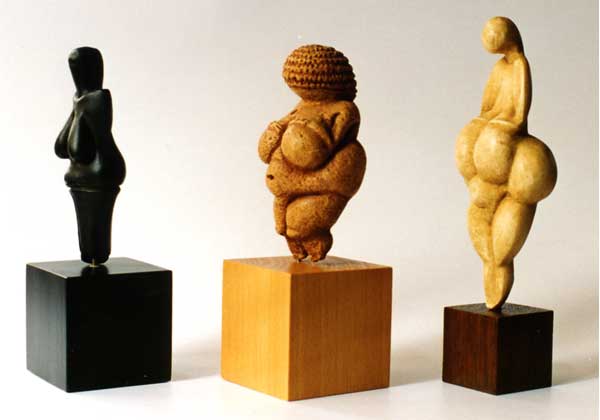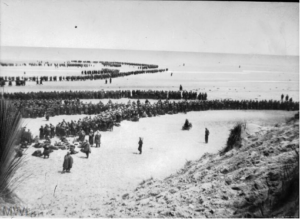Since the early stages of human life and prosperity, art has used by different societies to display their craftsmanship and to demonstrate their beliefs. Two types of artistic creations are the paleolithic Venus figurines from southern France and the bronze age jade figurines of China. These two art pieces contrast in both usage and symbolism. The figurines in the paleolithic, European era were made by hunters and gatherers, while jade figurines during the Bronze Age are part of an advanced civilization. Still, both provide scholars insight into the practices and goals of the people at the time.

One of the earliest forms of art includes the figurines from the European paleolithic era. Created by homo sapiens about thirty thousand years ago, they were called Venus figurines by scholars after the Roman goddess of love Venus, because they depict the body of a woman. Today, more than one hundred have been found and they all have similar characteristics. The figurines range in height but are on average 150mm tall. They are made from materials such as steatite, calcite, limestone, bone, ivory, and clay.1
Today we wonder about the meaning and purpose behind the faintness of facial features and hands in these figurines, yet we note the emphasis on the woman’s hips and legs. Although we do not yet have definite answers to this question, there are many theories available. One popular theory is that the societies that created these figurines had a deep interest in female fertility. Other theories mention their hope for survival and fear for extinction.2 A less popular and more controversial theory is the possibility that Venus figurines were self portraits.3 Still, different theories are necessary in order to better comprehend the motifs behind the Venus figurines and their crafters.

In contrast to the Venus figurines in Europe, Chinese jade figurines offer a clearer sense of the usage of art in the Bronze Age. Jade figurines were often buried with wealthy individuals along with their former slaves, food, jewels, and many other objects. Although the jade figurines took very long to make and were a process of hard labor, their symbolism of prosperity and luxury in Chinese ceremonial traditions demonstrate the practice of ancestral worship and how important it was to them. Because they believed spirits passed into another realm of existence, from which they had the power to affect future generations, tombs were lavished with tools so that masters might live plentifully along with sacrificed slave bodies that would continue to serve their master. For example, in the tomb of lady Fu Hao, wife of the Shang king Wu Ding, 755 jade carvings, 468 bronze objects, 130 weapons, and 4 mirrors were buried.4
Although prehistoric pieces such as figurines, cave paintings, and carvings are often overlooked because of the ambiguity of their meaning, they convey people’s emotions, ideas, and talents. Creations such as the Venus and jade figurines provide the world insight into the practices of our ancestors and the kinds of resource available to them. They serve as a timeline and teach us about their interests and abilities in eras as diverse as the European Paleolithic and Chinese Bronze Ages.
- Kaylea Vandewettering, “Upper Paleolithic Venus Figurines and Interpretations of Prehistoric Gender Representations,” PURE Insights 4, no. 1 (May 29, 2015), http://digitalcommons.wou.edu/pure/vol4/iss1/7. ↵
- Jerry H. Bentley, Herbert F. Ziegler, Traditions and Encounters: A Global Perspective on the Past Volume 1: From the Beginning to 1500 (New York, NY: McGraw-Hill, 2011), 14. ↵
- Kaylea Vandewettering, “Upper Paleolithic Venus Figurines and Interpretations of Prehistoric Gender Representations,” PURE Insights 4, no. 1 (May 29, 2015), http://digitalcommons.wou.edu/pure/vol4/iss1/7. ↵
- Jerry H. Bentley, Herbert F. Ziegler, Traditions and Encounters: A Global Perspective on the Past Volume 1: From the Beginning to 1500 (New York, NY: McGraw-Hill, 2011), 92-93. ↵



61 comments
Emily Davey
Very interesting how the artifacts are not only stories of a culture and its beliefs, but also a timeline for the development of human skill, I hadn’t thought of them like that before. I tend to agree with the belief that the artifacts resembling the femenine form are meant as fertility symbols, both for health and for harvest. The harvest theory I think comes more from later research, such as symbols of Persephone or other godesses who had multiple things they represented. Good article, and very informative!
Sara Alvirde
Art history has always been so interesting for me because of how you can depict the emotion of beliefs someone had from their time. As well as figure out what materials a group of people had and how maybe it is harder to find in our century. And just like any other art sculpture, its amazing to see how precise and articulate the artist created this piece with the measurements and such.
Elizabeth Santos
Art history is always fascinating, and this article is not an exception! These figurines made in these ancient civilizations are always so intricate and laced with so much meaning. I had heard about jade being especially resourceful in China, but this article was able to educate me more on the use of it within art. I have noticed that figurines and cave paintings tend to be overlooked, but being able to discern the multitude of possible meanings is what makes the art memorable and live long.
Sofia Martinez
I found it interesting how most figurines were influenced and represented a woman’s body, why were they heavily influenced by this? How did this make a better representation for their culture? I believe that this article has helped me understand better for this culture and the main point for figurines are, since I didn’t know what they were in the first place.
Margaret Maguire
This was a really neat article talking about the Venus figurines in Europe and Asia. I think it is really cool that Europe and Asia had similar concepts for the figurines but made them out of different materials. In Europe they were made of limestone or bone while in Asia the figurines were made of jade, a type of stone. They would bury the figurines with people to act as a way of showing their wealth and prosperity to others.
Amelia Hew
It’s interesting on how ancient civilization was able to come up with creative ideas and managed to craft intricate figures despite a lack of technologies. It’s hard to imagine how long it would take to complete one figure and how skilled a person must be to accomplish the task. I have to say that the designs of the figure and the reason behind the design were intriguing. It seems that many cultures such as Chinese, Egypt and the Europe uses different figures in burials as a display of power or to ensure that the dead can go to the afterlife.
Victoria Muller
I find it impressive how many types of materials the Venus figurines were able to be made from. It is even more interesting how so many ideas can come from figurines and yet we still don’t know all of their true meanings or purposes. Its fascinating how much hard work is put into making a figurine the symbolism of the jade figurines and its importance to their culture and tradition was a very interesting thing to learn about.
Amanda Quiroz
This was actually a very interesting article. It’s amazing to listen to the different theories people can come up with through figurines. I always looked at figurines and have imagined the culture and society in which they were created but have never thought about the meanings or stories that come with them. We’ll never know the true meanings behind them, which makes it even more interesting to ponder over.
Makenzie Santana
I thought this article was really interesting about figurines. I had no ideas that to fall under the category of figurines there were certain requirements like the material it’s made out of, the size, the formations, etc. It really is a mystery to the everyday person that is over looked when it comes to the meanings behind figurines and why they were created in the first place.
Nadia Carrasco
I had never seen or read about figurines so when I saw this article I thought it would be interesting. Never knowing about figurines I had no idea there were different types or purposes. It is cool how important they are but yet their meanings have not been found. I find it fascinating how people from thousands of years ago created these from nothing and we today with all out technology can not figure them out.